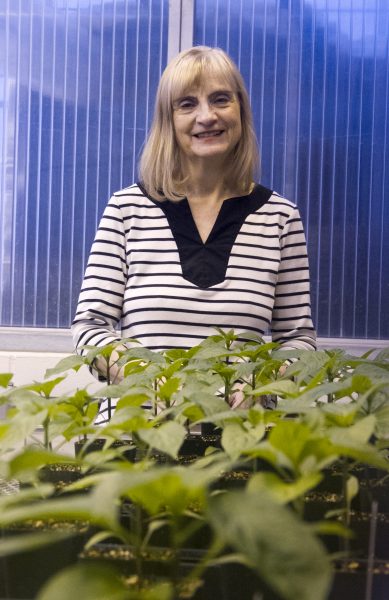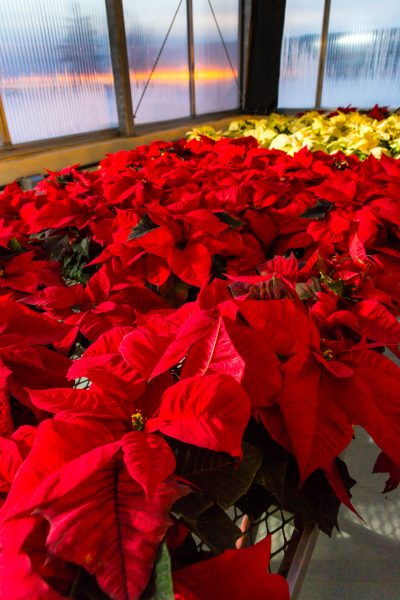Fascination with light keeps Karlsson focused on northern horticulture
March 28, 2017
Debbie Carter
907-474-5406

Download text and photo captions here.
Meriam Karlsson grew up on a small dairy farm in southern Sweden, where her family raised hay, barley and oats for a herd of 20 to 30 cows.
Agriculture seemed like a logical career path, but Karlsson found plants and crop production more compelling than animals, so she studied horticulture in Sweden and at Michigan State University. While earning her doctorate, she became interested in the effects of temperature and light on plants, particularly flowering plants produced in greenhouses.
The horticulture professor has continued work in this area for nearly 30 years at the University of Alaska Fairbanks. The extreme day lengths and short field seasons in Alaska intrigued her from the start, and they still do.
“It made sense to study lights and temperatures in Alaska,” she said.
Karlsson’s current research centers on greenhouse and controlled-environment crop production, controlled-environment technology and resource management in commercial greenhouses.
Not all light is the same, whether in nature or the greenhouse. Because Alaska greenhouses need a lot of supplemental lighting, she is studying LEDs, which use less energy but provide a different quality of light than traditional sodium lights. Karlsson is looking at how the different combinations of colors in LEDs affect plant growth and is developing guidelines for Alaska greenhouse operators to use.
She has found that LEDs work best for seedlings and plants that grow close to the ground and that different plants at different stages need different types of light.
Much of her work concerns greenhouse food production because of the interest in local foods, Karlsson said. Her office is a few steps down the hall from the research greenhouse on the south side of the Arctic Health Research Building.
One area in the greenhouse holds flats of 6-inch-high orange and red bell peppers that she is growing as part of a trellising experiment. Little research has been done in Alaska with peppers, which are a good potential greenhouse crop, she said. To optimize greenhouse space and productivity, the plants are trellised, with two lateral branches that grow from the main stem. The horticulturist is looking at how pruning the lateral branches affects production.

The greenhouse on West Ridge also holds red, cream-colored and speckled poinsettias, grown for the benefit of students in her applied plant science class. The flowers demonstrate the effects of different light and temperature treatments. Karlsson teaches a sustainable agriculture course with two other professors and a class in greenhouse management this spring. The greenhouse class is popular among students, some of whom want to operate their own greenhouses.
Eric Cook is among those who have learned from Karlsson. Before coming to work for her in 2014, Cook had studied horticulture and worked in greenhouses in Guam, Oregon and Wyoming and at Chena Hot Springs. But he had not worked in a research greenhouse with state-of-the-art climate and light controls until he worked with Karlsson for a year. Cook said he learned about scientific design and trials, the use of beneficial insects to control pests and more about greenhouse controls and lighting.
“I definitely picked up some skills from her,” said Cook, who is now the greenhouse coordinator at Red Butte Garden and Arboretum in Salt Lake City. He described Karlsson as quiet, kind and well-liked by students.
As part of a project funded by the Division of Agriculture, Karlsson will compare the nutritional value of locally produced vegetables and fruit this summer to that of imported produce in grocery stores. She will look at different varieties of tomatoes, lettuce and spinach, and possibly other vegetables. Some of the locally grown produce will be grown in the university greenhouse and some will be purchased from farmers markets. She will analyze the vegetables’ sugar and mineral content in university labs, and a lab in the Lower 48 may evaluate antioxidant levels.
“We hope that locally grown is more nutritious,” she said. “We want to get some good documentation to show that.”
Karlsson is also trying to develop greenhouse protocols for growing spinach, which is in demand but difficult to grow outside because it bolts and flowers under the long daylight hours. Growing spinach with LEDs seems to delay flowering, but more work needs to be done to see if it can be grown commercially throughout the year in greenhouses, she said.
Karlsson does not take much time away from her greenhouse or her research.
“My plants grow 24-7,” she explained. “It’s an exciting area. Growing is a good field to be in.”


